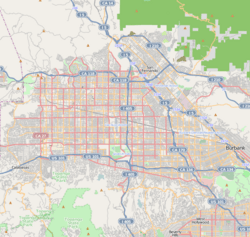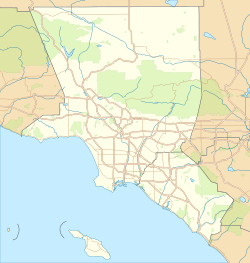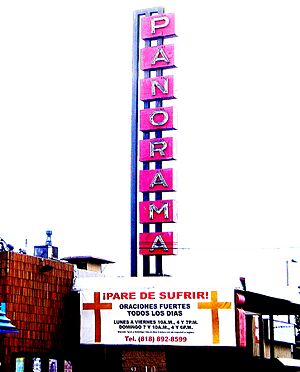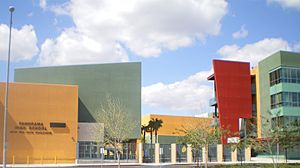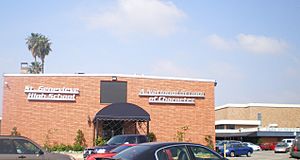Panorama City, Los Angeles facts for kids
Quick facts for kids
Panorama City
|
|
|---|---|
| Country | United States |
| State | California |
| County | Los Angeles |
| City | Los Angeles |
Panorama City is a neighborhood in Los Angeles, California, located in the San Fernando Valley. It's known for having many young people and a high population density for the Valley. More than half of the people living here were born outside the United States, mostly from Mexico.
Panorama City was the first "planned community" in the Valley. This means it was carefully designed and built after World War II when many new homes were needed. Over the years, it has been home to several famous people. Today, you'll find a mix of single-family houses and apartment buildings.
The neighborhood has three high schools, two community centers, a senior center, an ice rink, and two hospitals.
Contents
History
Panorama City is famous for being the first planned community in the San Fernando Valley. It was created in 1948 by a builder named Fritz B. Burns and an industrialist named Henry J. Kaiser. They worked together to design the whole area.
After World War II, many soldiers came home and started families. Fritz B. Burns saw that a lot of new homes would be needed. So, in 1945, he teamed up with Kaiser to form Kaiser Community Homes. Most of the houses were bought with special loans for veterans, which helped many families get their own homes.
In the past, some homes in the area had unfair rules about who could live there. These rules, called "restrictive covenants," sometimes said that only people of a certain race or religion could own property. These kinds of rules were common in many communities back then. However, these rules are now illegal and cannot be enforced.
Over time, Panorama City became more diverse. This happened partly because new laws made sure that everyone, no matter their race or income, could get loans to buy homes. This helped people from different backgrounds move into the community.
Panorama City used to be next to a very large General Motors car factory. Today, that factory has been replaced by a big shopping center called The Plant. You can see a mural (a large painting) on Van Nuys Boulevard that honors the history of the old GM plant.
Geography
Panorama City is located near several other neighborhoods. To the north, it touches Mission Hills. To the northeast is Arleta, and to the east is Sun Valley. On the southeast, you'll find Valley Glen, and to the south is Van Nuys. Finally, North Hills is to the west.
The community mostly has smaller single-family homes and apartment buildings that are not very tall.
People Living Here
In 2010, about 69,817 people lived in Panorama City. The average age was around 30 years old.
In 2008, a project called Los Angeles Times Mapping L.A. described Panorama City as a "moderately diverse" area. This means it has a good mix of different ethnic groups. A large number of people are Latinos, and there's also a significant population of Filipinos. The most common backgrounds were from Mexico and the Philippines.
About 70% of the people were Latinos, 11.5% were whites, and 11.9% were Asians. Many residents, about 55%, were born outside the United States. Most of these people came from Mexico (52.1%) and El Salvador (13.4%).
As of 2010, about 65% of the homes were rented, while 35% were owned by the people living in them.
Parks and Recreation
Panorama City has great places for fun and activities!
The Panorama Recreation Center is a popular spot. It has an auditorium, a lighted baseball field, lighted outdoor basketball courts, and a playground for kids. There's also a community room, an indoor gym, and picnic tables. You can also find tennis courts here.
The Sepulveda Recreation Center is another large center. It has two indoor gyms that can also be used as auditoriums. Outside, you'll find a lighted baseball field, lighted indoor basketball courts, a children's play area, and lighted tennis courts. The Sepulveda Pool is an outdoor pool at this center, open during certain seasons.
The Mid-Valley Senior Citizen Center is also in Panorama City. It has an auditorium, a kitchen, and a stage. This center provides a place for older adults to gather and enjoy activities.
The LA Kings Valley Ice Center is a cool place to skate! It used to be called the Valley Skating Center. This facility has two ice rinks. You can join programs for adult and youth ice hockey, or learn to play hockey and figure skating. They also have times for public skating and special sessions for practicing. You can even rent a rink for birthday parties or other events. The center is home to the California Heat amateur hockey club, which is part of a large youth league.
Shopping and Business
Panorama City was once the biggest shopping area in the San Fernando Valley. This started in 1955 with the opening of what is now the Panorama Mall. Back then, it was a smaller complex with a few stores. Over the next ten years, more big department stores opened nearby, and the whole area was known as the Panorama City Shopping Center.
By the 1970s, other communities started to attract shoppers. Today, the Panorama Mall is still an important local shopping center. It has stores like Walmart and Curacao, which is popular with Hispanic shoppers.
Education
In 2000, about 13% of adults aged 25 and older in Panorama City had a four-year degree. This was about average for Los Angeles. However, a higher percentage of people had not finished high school compared to the rest of the county.
Here are some of the schools in Panorama City:
Public Schools
- Panorama High School, 8015 Van Nuys Blvd.
- Liggett Street Elementary School, 9373 Moonbeam Avenue
- Primary Academy for Success, elementary, 9075 Willis Avenue
- Valor Academy Charter, middle, 8755 Woodman Avenue
- Panorama City Elementary School, 8600 Kester Avenue
- Chase Street Elementary School, 14041 Chase Street
- Vista Middle School, 15040 Roscoe Boulevard
- Burton Street Elementary School, 8111 Calhoun Avenue
- Cal Burke High School, continuation, 14630 Lanark Street
- Ranchito Avenue Elementary School, 7940 Ranchito Avenue
- Michelle Obama Elementary School, 8150 Cedros Avenue
- Alta California Elementary School, 14839 Rayen St
Private Schools
- St. Genevieve Elementary School, 14024 Community Street
- St. Genevieve High School, 13967 Roscoe Boulevard
Healthcare
Panorama City has two hospitals that serve the community.
Kaiser Permanente has a large hospital and medical center. It first opened in 1963 and covers three city blocks. Mission Community Hospital is another hospital in the neighborhood. It has an emergency room, surgical services, and offers other medical care.
Notable people
- David Smith, volleyball player and Olympian
- José Benavidez, Professional boxer
- Kirk Cameron, actor, Christian evangelist
- Candace Cameron Bure, actress
- Terry Gilliam, Monty Python member and film director
- Meagan Good, actress
- Mark-Paul Gosselaar, actor
- Hopsin, rapper
- Mike Shinoda, musician
- Giancarlo Stanton, Major League Baseball player
- Sara Velas, artist
- Steve Wapnick, baseball player
- Zack Britton Professional Baseball pitcher for the New York Yankees
- Angela Ruggiero Women's ice hockey player, Gold medalist
- Randy Myers (animator)
See also
 In Spanish: Panorama City para niños
In Spanish: Panorama City para niños


